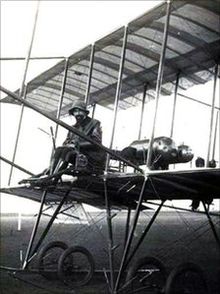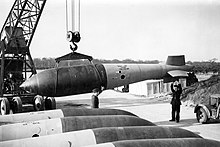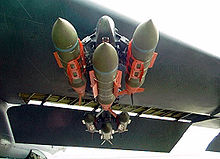avia.wikisort.org - Weapon
An aerial bomb is a type of explosive or incendiary weapon intended to travel through the air on a predictable trajectory. Engineers usually develop such bombs to be dropped from an aircraft.


The use of aerial bombs is termed aerial bombing.
Bomb types
Aerial bombs include a vast range and complexity of designs. These include unguided gravity bombs, guided bombs, bombs hand-tossed from a vehicle, bombs needing a large specially-built delivery-vehicle; bombs integrated with the vehicle itself (such as a glide bomb), instant-detonation bombs or delay-action bombs.
As with other types of explosive weapons, aerial bombs aim to kill and injure people or to destroy materiel through the projection of one or more of blast, fragmentation, radiation or fire outwards from the point of detonation.
Early bombs



The first bombs delivered to their targets by air were single bombs carried on unmanned hot air balloons, launched by the Austrians against Venice in 1849 during the First Italian War of Independence.[1]
The first bombs dropped from a heavier-than-air aircraft were grenades or grenade-like devices. Historically, the first use was by Giulio Gavotti on 1 November 1911, during the Italo-Turkish War.[2]


In 1912, during the First Balkan War, Bulgarian Air Force pilot Christo Toprakchiev suggested the use of aircraft to drop "bombs" (called grenades in the Bulgarian army at this time) on Turkish positions.[citation needed] Captain Simeon Petrov developed the idea and created several prototypes by adapting different types of grenades and increasing their payload.[3]
On 16 October 1912, observer Prodan Tarakchiev dropped two of those bombs on the Turkish railway station of Karağaç (near the besieged Edirne) from an Albatros F.2 aircraft piloted by Radul Milkov, for the first time in this campaign.[3][4][5][6]
Technical description
Aerial bombs typically use a contact fuze to detonate the bomb upon impact, or a delayed-action fuze initiated by impact.
Reliability
Not all bombs dropped detonate; failures are common. It was estimated that during the Second World War about 10% of German bombs failed to detonate, and that Allied bombs had a failure rate of 15% or 20%, especially if they hit soft soil and used a pistol-type detonating mechanism rather than fuzes.[7] A great many bombs were dropped during the war; thousands of unexploded bombs which may be able to detonate are discovered every year, particularly in Germany, and have to be defused or detonated in a controlled explosion, in some cases requiring evacuation of thousands of people beforehand. Old bombs occasionally detonate when disturbed, or when a faulty time fuze eventually functions, showing that precautions are still essential when dealing with them.
See also
- Aerial bombing of cities
- Area bombardment
- Bomber
- Explosive weapons
- Strategic bombing
- Tactical bombing
Types of aerial bomb:
- Cluster bomb
- Concrete bomb
- Earthquake bomb
- Incendiary bomb
- General-purpose bomb
- Gravity (dumb) bomb
- Guided (smart) bomb
References
- Millbrooke, Anne (2006). Aviation History. Jeppesen. pp. 1–20. ISBN 0-88487-235-1.
- Grant, R.G. (2004). Flight - 100 Years of Aviation. Dorling-Kindersley Limited. p. 59. ISBN 9780751337327.
- Who was the first to use an aircraft as a bomber? (in Bulgarian; photographs of 1912 Bulgarian air-dropped bombs)
- A Brief History of Air Force Scientific and Technical Intelligence Archived 30 December 2008 at the Wayback Machine
- "The Balkan Wars: Scenes from the Front Lines". Time. 8 October 2012. Retrieved 28 July 2015.
- I.Borislavov, R.Kirilov: The Bulgarian Aircraft, Vol.I: From Bleriot to Messerschmitt. Litera Prima, Sofia, 1996 (in Bulgarian)
- Brian Melican (23 April 2018). "'They haven't lost their potency': Allied bombs still threaten Hamburg". The Guardian. Retrieved 23 April 2018.
External links
- "bomb" at Encyclopædia Britannica
На других языках
[de] Fliegerbombe
Eine Fliegerbombe (auch Abwurfkampfmittel bzw. Abwurfmunition) ist eine Bombe, die aus einem Flugzeug, meist einem Bomber, abgeworfen wird und, je nach Zündsystem, beim Aufprall, in geringer Höhe über dem Boden, nach Durchschlag eines Zieles oder verzögert explodiert. Ungelenkte Bomben sind, aus großer Höhe abgeworfen, eine sehr ungenaue Waffe, weshalb oft eine größere Fläche mit Bomben belegt wird, um so die Streuung auszugleichen und das eigentliche Ziel zu treffen. Heute übliche Bomben steuern sich meistens selbst ins Ziel (vgl.: Präzisionsgelenkte Munition), sind aber wegen möglicher Fehlfunktion und der in Mitleidenschaft gezogenen Umgebung des Ziels ethisch umstritten. Sie werden häufig als unzivilisiertes und verwerfliches Mittel der Kriegsführung gesehen. Das Bombardieren von Flächen (Flächenbombardement) wurde oft als Terrorangriff angewendet, um Angst und Schrecken in der Bevölkerung zu verbreiten, möglichst viele Menschen zu töten oder zu verletzen und die Infrastruktur zu zerstören.- [en] Aerial bomb
[it] Bomba aeronautica
Una bomba aerea è un tipo di bomba ideata per viaggiare attraverso l'atmosfera terrestre secondo una traiettoria pianificata, in genere partendo da un aeromobile. Le bombe d'aereo sono realizzate in una vasta gamma di tipologie e con differenti complessità, spaziando dalle bombe a caduta libera fino alle più sofisticate bombe guidate, dette nel linguaggio militare inglese guided bomb unit o GBU. Vi sono state bombe aeronautiche lasciate cadere a mano dagli aerei agli albori dell'aviazione, mentre modernamente si è arrivati a impiegare speciali grandi contenitori per il rilascio degli ordigni fino ad arrivare a creare aeromobili che essi stessi erano delle armi definite del tipo bombe plananti. Tra le possibili varianti tecnologiche vi sono quelle relative al tipo di spoletta impiegata e conseguente capacità di esplodere immediatamente all'impatto o dopo un ritardo predeterminato.[ru] Авиационная бомба
Авиационная бомба или авиабомба — один из основных видов авиационных средств поражения (АСП). Сбрасывается с самолёта или другого летательного аппарата, отделяясь от держателей под действием силы тяжести или с небольшой начальной скоростью (при принудительном отделении).Другой контент может иметь иную лицензию. Перед использованием материалов сайта WikiSort.org внимательно изучите правила лицензирования конкретных элементов наполнения сайта.
WikiSort.org - проект по пересортировке и дополнению контента Википедии